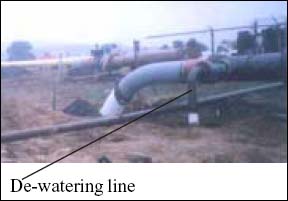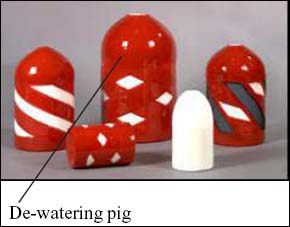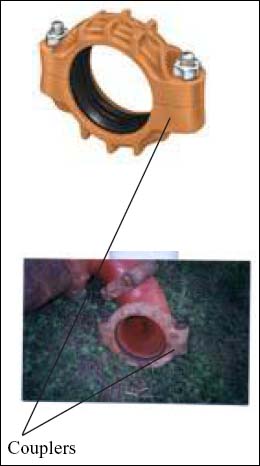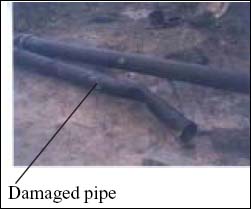|
 |
U. S. Department of Labor
Occupational Safety and Health Administration
Directorate of Science, Technology & Medicine
Office of Science and Technology Assessment |
U.S. Department of Transportation
Research and Special Programs Administration
Office of Pipeline Safety |
 |
Hazards Associated with De-Watering of Pipelines
|
Safety and Health Information Bulletin
SHIB 06-21-2004 |
Advisory Bulletin
ADB-04-01 |
|
|
This Safety and Health Information Bulletin is not a standard or regulation, and it creates no new legal obligations. The Bulletin is
advisory in nature, informational in content, and is intended to assist employers in providing a safe and healthful workplace. The
Occupational Safety and Health Act requires employers to comply with hazard-specific safety and health standards. In addition, pursuant to
Section 5(a)(1), the General Duty Clause of the Act, employers must provide their employees with a workplace free from recognized hazards
likely to cause death or serious physical harm. Employers can be cited for violating the General Duty Clause if there is a recognized hazard
and they do not take reasonable steps to prevent or abate the hazard. However, failure to implement any recommendations in this Safety and
Health Information Bulletin is not, in itself, a violation of the General Duty Clause. Citations can only be based on standards, regulations,
and the General Duty Clause.
|
Preface
Two workers recently were killed in accidents that occurred during the de-watering of natural gas pipelines, a process conducted following
the construction of the pipelines. The victims were killed when they were struck by temporary de-watering piping, which was not properly
anchored and broke loose from its coupling from excessive air pressure. The Occupational Safety and Health Administration (OSHA) and the
Office of Pipeline Safety (OPS) urge that all persons working on, or in close proximity to, de-watering processes be alerted to this
serious hazard and take appropriate steps to prevent death or serious injury.
Purpose
The purpose of this Safety and Health Information Bulletin (SHIB)/Advisory Bulletin
(ADB) is to highlight:
- potential hazards associated with pipeline de-watering operations;
- work practices and guidelines that can reduce the potential for unexpected separation of temporary de-watering pipes; and
- training that can help to protect employees from these hazards.
Accident Description
The OSHA Allentown and Wilkes-Barre Area Offices recently investigated two fatalities that occurred in conjunction with de-watering
processes associated with newly constructed natural gas pipelines. In both cases, the temporary de-watering piping violently separated from
its couplings, striking and fatally injuring employees. In one instance, the separated section of pipe was thrown 45 feet from where it had
been attached to the temporary de-watering valve. OSHA determined that a major contributing factor to both of the accidents was temporary
de-watering pipelines that were not adequately secured to prevent the piping from moving or separating. In one case, the failure occurred at
a pipe coupler that was not being used within the safe tolerances established by the manufacturer.
Background

Figure 1
De-watering line

Figure 2
De-watering pig

Figures 3 and 4
Couplers

Figure 5
Damaged pipe
|
After a pipeline is laid, a hydrostatic test is conducted to ensure its integrity. Hydrostatic testing may also be
conducted during the service life of the pipeline to evaluate its operational integrity.
The hydrostatic test consists of pumping water into the pipeline, "pressuring up" the line to specified test pressures, and holding that
pressure for a discrete period of time in accordance with applicable regulations and guidelines, including regulations promulgated by OPS.
After completion of the hydrostatic test, the pressure is relieved and the water is removed from the pipeline (de-watering).
The de-watering process involves connecting a temporary de-watering line (figure 1) to the main pipeline with mechanical couplers and
adequately securing the temporary de-watering line to prevent displacement. A de-watering "pig" (figure 2) is then forced through the main
pipeline using several hundred pounds pressure of compressed air. As the pig is forced through the pipeline with air pressure, the water
remaining in the line from hydrostatic testing is pushed out of the main pipeline through the temporary de-watering line.
During the de-watering process, significant and sudden variations in pressure often occur within the main pipeline and temporary de-watering
line. These variations can be caused by changes in pig velocity as it passes through bends in the pipeline or changes in pig and water
velocity due to changes in pipeline elevation. Compressed air escaping around the pig, which can combine with air already present in the main
pipeline at high spots in the pipe, can also create a source for stored energy within the main pipeline. These sudden pressure changes
produce surges that are transferred from the main pipeline to the temporary de-watering line. This can result in movement of the temporary
de-watering line, as the pressures can easily exceed the working pressures and bending capabilities of the temporary de-watering line
couplers. The movement of the de-watering line can result in violent failure of the temporary piping system, particularly when the temporary
piping is not properly anchored. This situation can be exacerbated when the temporary pipeline suddenly changes direction, when couplers or pipe sections (figures 3, 4 and 5) have worn beyond the specified tolerances
established by the manufacturer of the de-watering piping system, or when the entire de-watering manifold is inadequately designed for the
stresses that can be imposed while de-watering.
OPS regulates pipeline safety, recognizes the existence of hazards associated with testing pipelines, and requires operators to protect their
employees and the public during hydrostatic testing. 49 CFR 192.515(a) states that "…each operator shall insure that every reasonable
precaution is taken to protect its employees and the general public during the testing [required before natural gas pipelines are placed
into service or when pipelines are retested to confirm operational integrity]." 49 CFR 195.402(c) requires each pipeline operator to prepare
and follow procedures for safety during maintenance and normal operation.
Although OSHA has no specific regulations addressing the design or securing of de-watering piping systems, the Agency is aware of workplace
injuries and fatalities caused by improper anchoring or restraining of temporary de-watering pipes. OSHA’s authority is limited by Section
4(b)(1) of the Occupational Safety and Health Act (OSH Act), which precludes OSHA from regulating working conditions over which other federal
agencies "exercise statutory authority to prescribe or enforce standards or regulations affecting occupational safety or health." 29 U.S.C.§
653(b)(1). Thus, OSHA’s authority to address occupational safety and health hazards associated with pipelines is controlled by the scope and
nature of OPS regulations. In practice, OSHA authority over working conditions associated with pipeline de-watering operations generally
is limited to employers (e.g., contractors hired by pipeline operators), and their workers, who are not covered by OPS regulations.
Description of Hazards
Lack of Anchoring
The potential for separation of a pressurized pipeline is a recognized hazard in related industries and applications. The oil and gas industry
has long recognized this hazardous condition in several operations, and there are published consensus industry standards addressing the
potential for such failure [1,2,3]. These standards recommend the securing or anchoring of pressurized flow, bleed-off, and blow-down lines
to prevent movement. Persons experienced with hydrotest de-watering processes also recognize this potential hazard, and it is accepted
industry practice to adequately anchor or secure de-watering pipe to prevent pipe movement, separation, and/or whipping.
Worn Couplings
The condition of the couplings, which are used to attach the de-watering pipe to the main gas line and other temporary de-watering pipe
sections, likely contributed to one of the accidents that OSHA investigated. In that case, the failure occurred at a pipe coupler that was
not within the manufacturer’s established tolerances. With the added pressure of the de-watering process, a damaged or improper coupler could
contribute to the separation of temporary pipe sections. It is imperative that all connections and fixtures be in proper working condition.
The groove installed on the pipe needs to be conformed to manufacturer specifications and guidelines, be properly fitted, as specified by the
engineer who develops the de-watering plan, and chosen for the application.
Excessive and Variable System Pressures
During de-watering, the de-watering pig is pushed through the pipeline using compressed air. The pressure exerted on a piping system,
including the de-watering piping, can be much greater than that indicated by gauges on the air compressor(s). Where terrain includes hills,
slopes, or other changes in elevation, the pressure on the de-watering system can be increased significantly by the hydrostatic head pressure,
adding to the potential for pipe separation.

Figure 6
90° Elbows
|
It is possible for the pig to become stalled or stuck in the line. Whether the pig becomes stalled because of air flow around the pig or
stuck because of debris inside the pipe or faulty seals, freeing the stuck pig can be problematic. At times, workers will use increased air
pressure to attempt to move the pig. While increasing the line pressure is an accepted practice, the safe pressure limits of the pipeline
and connections must never be exceeded. If the pressure limits of the main piping or de-watering systems are exceeded, there may be a
catastrophic failure of the pipe, or more likely, the pipe connections.
Fittings, such as elbows (figure 6) in piping systems, and other factors also can contribute to pressure variation as the pig passes through
the piping. Forces associated with those pressure changes can be transferred to temporary piping systems and cause movement and ruptures in
connections and piping. Employers should consider the forces involved, and they should design and install anchoring systems to properly
restrain or control de-watering
piping.
Lack of Training
It is imperative that employers train employees who perform or work near hydrotest de-watering operations. Employers engaged in
construction activities are required by the OSHA standards to "instruct each employee in the recognition and avoidance of unsafe conditions
and the regulations applicable to his work environment to control or eliminate any hazards or other exposure to illness or injury." 29 CFR
1926.21. Employers need to ensure that employees involved in de-watering of pipelines understand the potential hazards of the pressurized
lines and the precautionary measures and controls necessary to protect themselves and others working in the vicinity.
Exclusion Zone
During the testing and de-watering processes, there may be hazards that may not have been completely controlled. This might include the
possibility of unexpected high pressure in the pipe from internal malfunctions or irregularities, as well as failure of the pipe itself under
full test pressure from undetected imperfect welds. Such situations may exceed the designed capacities of the anchorages. Therefore, the
access to the test zone may be limited to only those persons who are necessary to perform the test.
Conclusions
It is recognized industry practice to anchor or restrain de-watering piping in order to prevent death or serious injury from de-watering
pipeline separation. Complete engineering analyses should be performed to determine requirements for the installation and use of de-watering
systems. Engineering designs and installation techniques should be developed for these temporary pipelines. In addition, employees
installing temporary pipelines should be trained in these designs and techniques, and they should follow them when installing these temporary
systems. Employers also should ensure that couplings and piping systems are sound and can withstand the pressures involved.
Recommendations
While there is no specific OSHA standard addressing de-watering of pipelines, the Occupational Safety and Health Act requires employers to
provide a workplace that is "free from recognized hazards that are causing or are likely to cause death or serious physical harm to his
employees." 29 U.S.C. §654(a)(1). To this end, employers need to ensure that proper procedures are followed and that employees who perform
de-watering processes are adequately trained and knowledgeable about proper procedures for restraining or anchoring of de-watering lines. The
following guidelines will help reduce the risk of injury to employees involved in de-watering activities:
- Study the piping system. During the initial planning stage of a de-watering operation, an engineering analysis of the existing and
temporary piping system should be performed to identify the pressure associated with fluids and other forces that could adversely affect the
integrity of the pipeline or the stability of the drainage and its components. The employer should design the de-watering system and develop
installation techniques based on the expected forces of the particular project. Alternatively, designs and techniques could be developed for
a "worst case" scenario that could be applied to all de-watering projects.
- Anchor the de-watering lines. It is accepted industry practice to adequately anchor or secure de-watering piping to prevent movement and separation of the piping. Employers should establish effective anchoring systems based on expected forces and ensure that the systems are used
during de-watering projects.
- Ensure condition of couplings and parts. All couplings and parts of the de-watering system need to be properly selected for their
application. The associated piping which the couplings connect is a significant variable in the entire mechanical piping system. The
couplings are manufactured in a controlled environment, and variations in the quality of the couplings should be limited. Employers should
ensure that couplings are within manufacturer’s tolerances and free of damage that may result in connection failure. A chain is only as
strong as its weakest link — in de-watering piping systems, the weakest link frequently is the temporary de-watering pipe connections.
- Provide adequate employee training. This training should instruct employees on de-watering installation designs and techniques, including
proper coupling and anchoring methods. Employers need to ensure that employees understand the potential hazards of improperly installed
de-watering systems, provide employees a means of determining whether the pipe groove meets manufacturer’s tolerances, and the procedures they
should implement to protect themselves and others working around them.
- Proper Procedures. Employers should ensure that proper installation and de-watering procedures are followed on the job site.
References
- American Petroleum Institute (API). Recommended Practice for Occupational Safety for Oil and Gas Well Drilling and
Servicing Operations. API RP 54-1999, Section 12.4.3.
- American National Standards Institute (ANSI). Power Piping. ANSI B31.1-1973, Section 121.2.
- U.S. Army Corps of Engineers (USACE). Safety and Health Requirements Manual. EM 285-1-1, 1996 Section 20.
- Federal Pipeline Safety Regulations. 49 CFR Part 192 & Part 195.
|
|

